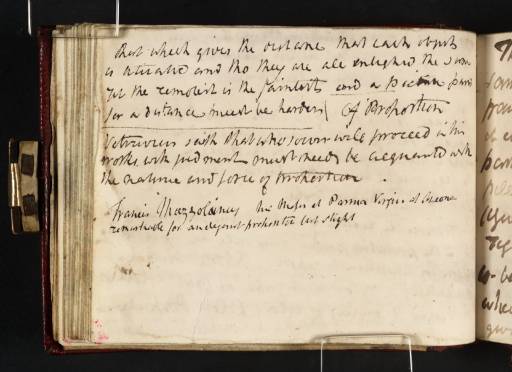Most of the page is taken up with the following notes:
that which gives the distance that each object | is situated and tho they are all enlightd the same | yet the remotest is the faintest and a picture painted | for a distance must be harder / Of Proportion | Vitruvius saith that whosoever will proceed in his | works with judment [sic] must needs be acquainted with | the nature and force of proportion
Francis Mazzol<[?a]>inus his Moses at Parma Virgin at Ancona | remarkable for an elegant proportion but slight
The underlining serves to separate the first sentence from the notes on proportion rather than necessarily being for emphasis.
Jerrold Ziff has identified these notes, continuing from the recto of the present leaf (
D07409), as free transcriptions from the 1598 English edition of Giovanni Paolo Lomazzo’s
Tracte Containing the Artes of Curious Paintinge Carvinge & Buildinge (see the sketchbook Introduction),
1 in this case from ‘The First Booke: Of the Naturall and Artificiall Proportion of Things’: chapter II, ‘Of the Division of Painting’, page 24 (up to ‘harder’); chapter III, ‘Of the Vertue and Praise of Proportion’, page 25 (to ‘force of proportion’); and chapter IX, ‘The Proportion of a Young Man of Nine Heads’, page 41.
The first passage concludes a note begun on the recto, concerning colour in relation to perspective. Vitruvius’s statement comes from chapter III. A marginal heading on page 41, ‘Mazzolinus error’, relates to the attenuated proportions of that painter’s figures; in Lomazzo’s view classical gods such as Apollo and Bacchus would have
warranted ... this his most acceptable proportion, which was ever slender, and oftentimes too sleight. But when he took upon him to expresse the Prophets, our Lady and the like in the same, as appeareth by his Moses at Parma, our Lady at Ancona, and certaine Angels ... and diverse other thinges quite contrary to the symmentry [sic] they ought to have, hee gave a precedent to all other Painters to shunne the like error: ... which example admonisheth us, that a Painter ought not to tie himselfe to any one kind of proportion, in all his figures; ...
‘Mazzolinus’ appears to be the Italian Mannerist painter Parmigianino (Girolamo Francesco Maria Mazzola, 1503–1540), whose
Moses is among his 1530s figures in the vault of S. Maria della Steccata, Parma. The Ancona picture of the Virgin is unidentified, but Parmigianino’s late, well-known
Madonna of the Long Neck (Uffizi, Florence) demonstrates his elongated style.
2Further passages of Turner’s extensive notes from Lomazzo appear later in the sketchbook, continuing on folio 38 verso (
D07418), after several pages of notes from other sources.

